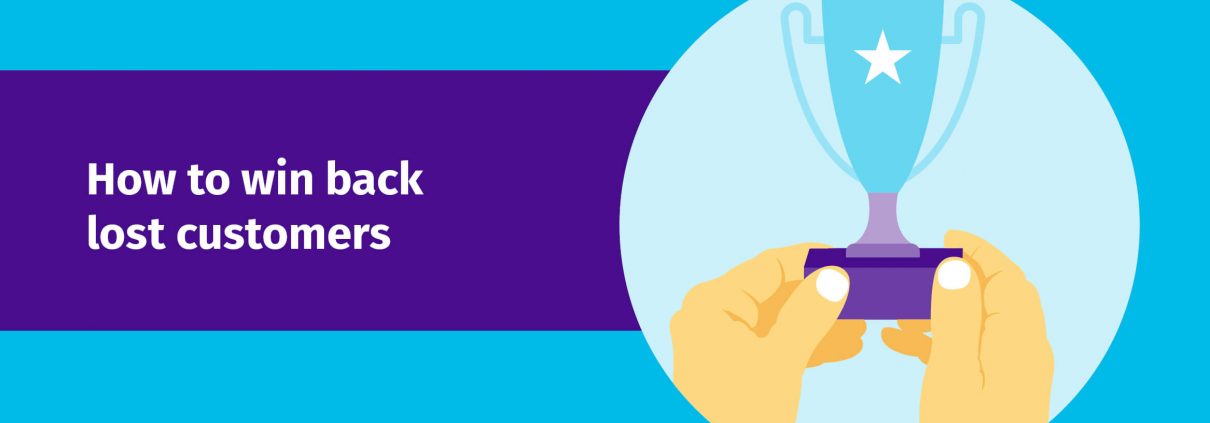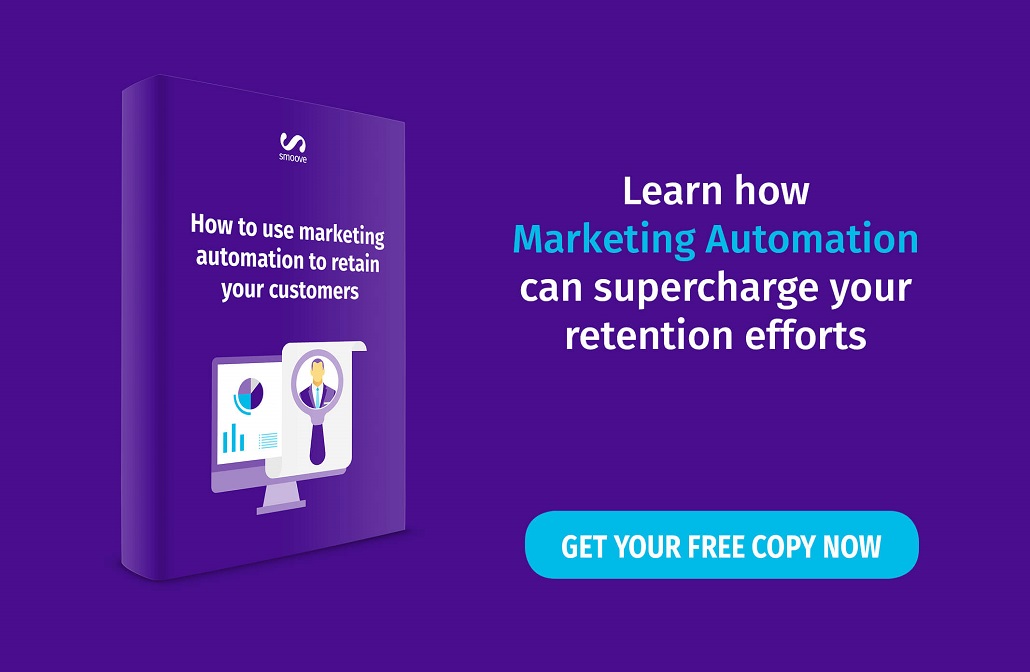How To Win Back Lost Customers
The first step in winning back a lost customer is knowing how to define a lost customer. Most companies, especially those who operate online, define a lost customer as one who hasn’t interacted with the site or service in a given time period. It’s important to keep an eye on customer churn rate because it’s more costly to acquire a new customer than it is to retain an existing customer.
With push notifications, email marketing, remarketing and SMS, it’s possible to get a customer who is on the edge to turn back and continue to do business with your brand, but there are valuable tactics to know to maximize your potential in retaining such customers.
Stages of Retention
Retention happens in stages, and the basic outline on steps to take include:
- Understand why a customer left (How: Ask for feedback via survey with incentives, phone calls, text message questionnaires, etc.)
- Find out their current situation, what are their needs, have the needs changed since the first interaction
- Make contact in the most optimal way for them to respond
While that may seem obvious, you can go a step further by segmenting customers after this preliminary research has been done into two groups: who can be won back easily versus who will bring more value if retained. Using RFM (recency, frequency, monetary) data will help inform the likelihood of a customer coming back – the higher the spend, number of times they spent, and timing since they last spent, the more likely they are to re-engage.
Once segmented, you can send personalized messages that acknowledge that you understand why they left in the first place, and then present them with the options or changes you’ve made that can satisfy their needs. If a customer has left because a competitor offered the same service at a better price, you can offer a discount or lower the price to adjust your perceived value and gain back the business.
It’s All About Timing
While offering discounts and incentives to return is important, it’s more about how you do it. Instead of offering a discount that is valid with no expiration, add some urgency to the message with a time-sensitive offer. For example, online clothes retailer, Joy, gives their win-back emails a one-week time frame for their customers to claim the discount.
Now, let’s say you’ve offered a customer a time-sensitive discount, but they have yet to redeem the offer. Perhaps, the cost wasn’t the problem, it was the subscription commitment or frequency of having to repurchase. A good example of a company that cleverly dealt with this scenario is Dollar Shave Club. As the name implies, Dollar Shave Club provides a cheap alternative to having to buy razors and automatically sends a new razor every month. But, some people neither need or want that many razors.
Dollar Shave Club overcame this by sending an email, anticipating this fact, and offered customers an easy way to opt into receiving razors bi-monthly instead. Rather than losing customers entirely because of the business’ default setup, they provided an alternative to customers whom they saw were waning (aka those who canceled or paused their subscription).
It’s useful to look at your product and it’s current set-up and define different personas and their needs. Then, create alternative options for those who may not fit the regular mold of your offers. Understanding your customers’ needs is the best way to keep them satisfied.
Since You’ve Been Gone Email Marketing
By using email marketing and segmentation to reach customers who have been inactive for a period of time, you can provide them with more than just offers. Sometimes a change in how you do business or a new product will entice them to come back.
It’s low-hanging fruit to message your lists with a newsletter-style email to update them on what’s happened in your business in the time since they’ve last interacted. Some examples of messages to share are: changes in management, new products, updated partnerships, philanthropic endeavors, and the like.
Here’s something to try: segment your audience based on campaign activity. If they haven’t been engaged (clicked or opened) any correspondence within the last 30 days, send a newsletter with updates, and a subject line like: “Since You’ve Been Gone…” or “Here’s What Happened!” Track the activity, and if you have re-engagement, follow up with a special welcome back offer to those customers. Email marketing tools like smoove make this easy to manage and execute with a cohesive dashboard. Source: Pexels
Source: Pexels
Ready to Retain, Partner
Another option is to partner with other companies in a similar space and leverage their credibility and market value to promote your product. For example, RunKeeper and New Balance have a partnership that keeps the brands constantly in the face (or extremities) of their customers.
Although people don’t buy new running shoes daily, they may use the RunKeeper app to track their runs daily, or at least weekly. Therefore, New Balance created an integration with the app where customers gain rewards from using the app that they can use towards their next purchase of shoes. This symbiotic partnership allows for brands to touch their customers at times they otherwise wouldn’t in their product’s life cycle and promotes greater retention benefits. It also builds brand loyalty and trust by association with an app they love to use.
To start taking advantage of this think about what companies are out there that you can partner with.
Remarket or Rebrand?
To a certain extent, implementing remarketing campaigns can help bring people back to you site in the event they have browsed but not made a purchase. But, sometimes your brand needs more help.
Like people, companies need makeovers, too. In 2018, the iconic Coca-Cola launched a multi-million dollar campaign to rebrand and better relate their product to the millennial market. By aligning with the idea that millennials seek “adventure and new experiences,” they created new sleeker cans and introduced four new flavors as consumer research found that Americans crave big and great-tasting flavors in their food and beverages. Centuries after its creation in 1886, Coca-Cola understands its customers’ needs and knows that staying on top of emerging trends can help retain customers in a highly competitive landscape.
Is your product still as relevant as it was? Can you do anything more to keep it as focused on customers needs of today just like Coke?
Update, Don’t Unsubscribe
It’s highly possible that your messages aren’t tailored for your customers. In that event, they are receiving emails and becoming easily fed up, which, ultimately will cause them to unsubscribe.
When a customer globally unsubscribes from your mailing system, you have lost the right to contact them at all. That’s why it’s imperative to offer your customers the option to update their subscriber profile and only opt-in to receive the kinds of messages they want, whether they be promotions/offers, company updates, etc. Get them to choose the right option for them, before they choose to never hear from you again. Then segment them based on this choice.
Ultimately, this goes hand in hand with creating different kinds of newsletters so that you open the door to communicate with customers on their terms. You can create different templates based on the information and create a content calendar so that you don’t spam customers with one type of newsletter too many times.
Text to Talk
Another form of communication that is useful for retention marketing is SMS messaging. You can conduct mobile polling to gain instant feedback on what a customer thinks about an existing product or service and potentially troubleshoot why they haven’t been engaged.
On average, customers read text messages within three minutes, so for instant communication, you can send targeted messages. For example, if you see a pattern when a customer usually shopped, you can send them a text message incentive on that day or during that time to incentivize them to come visit your store or site again.
It’s Never Too Late to Start
There’s an element of patience that’s necessary in warming up lapsed customers, but it doesn’t mean you should wait until it’s too late. Whether you choose to enact email marketing, SMS messages, or even an entire rebranding campaign, it all comes down to measuring results and staying consistent. If you have re-engagement, be sure to nurture those customers because they are putting their trust back in your brand, and they can’t be let down again.
While every customer is different, there are certain patterns and groupings that allow you to automate campaigns while still making them feel personalized. Remember to use RFM (recency, frequency and monetary) analysis to understand your audience, and engage them based on their actions. Marketing automation tools such as smoove can help you recognize patterns, segment your audience and re-engage them through automation.
People like free gifts. If all else fails, give a free offer to them and see if it’s enough to win-back your customer. Have you tried this tactic? If not, what are you waiting for?








Leave a Reply
Want to join the discussion?Feel free to contribute!